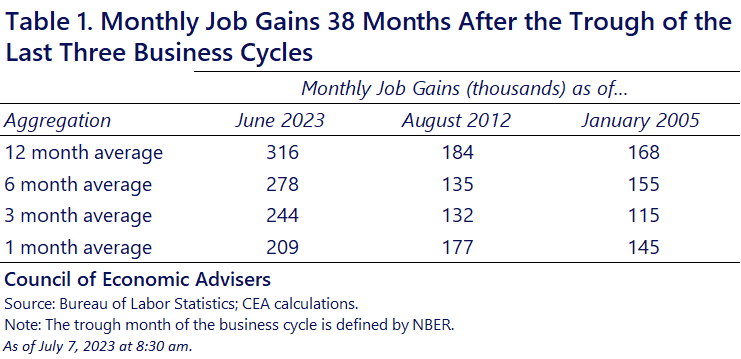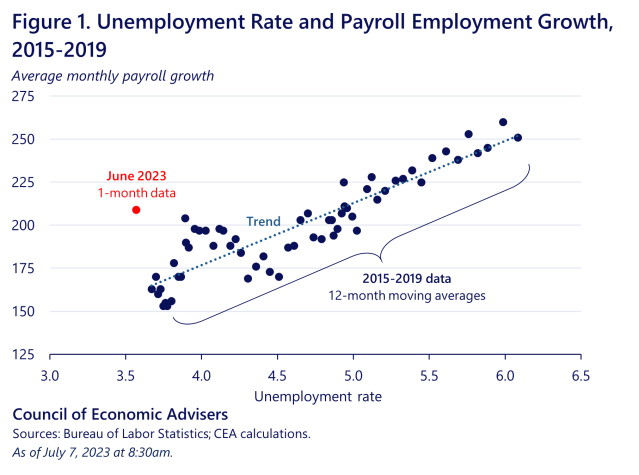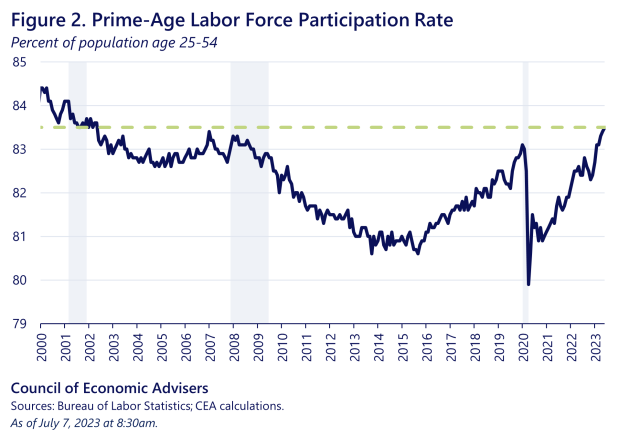The Employment Situation in June
Every month, the CEA and many other economic analysts dig into the monthly jobs report to learn what we can about where the job market is and where it might be headed. Such digging requires looking at jobs, industries, wages, and unemployment, and not just for one month but for numerous months, in order to pull out the underlying trend. Monthly data, which come from surveys and samples, can be noisy, and, as the CEA has emphasized in past Jobs Day blogs, averages over numerous months help to pull signal from noise.
Payroll employment was up 209,000 in June. The economy has added an average of 244,000 jobs over the past three months and 316,000 over the past year.
Are these numbers large, small, or somewhere in between? What can they tell us about where the job market is and where it might be headed?
It is useful to compare these gains to those of other business cycles at similar points. As economic business cycles proceed and the unemployment rate declines, job gains also tend to slow, much like when you are filling up a glass of water and you slow your pour as you get to the rim of the glass. One way to identify similar periods in different business cycles is to look at the same number of months out from the business cycle trough. The trough in a business cycle is the lowest point in a recession before a recovery begins. In the pandemic, this occurred in April 2020; therefore, it has now been 38 months since the trough.
Between June 2022 and June 2023, payrolls grew by 316,000 jobs per month on average, a much stronger record than the same point (38 months from the trough) in the previous two expansions (table 1). In fact, the magnitude of gains in this expansion is greater at each time span relative to the prior two expansions.[1]

Another way to put these job gains in context as the expansion proceeds is to plot them against the unemployment rate, shown in figure 1. The figure uses data from 2015-19 to show the end of the last business cycle and avoid pandemic distortions. The negative relationship shows how, late in expansions, job gains slow as the unemployment rate falls. Based on this correlation, a 3.6 percent unemployment rate would be associated with a monthly payroll gain of about 160,000, which indicates that June’s 209,000 is somewhat higher than we might expect at this stage in the expansion.

Sticking with the water glass analogy above, you cannot fill the glass if you do not have the water. In this case, “water” means labor supply—the almost 167 million people that make up the U.S. job market. One reason for the consistently strong job gains in the current recovery—or for that matter, the 13.2 million jobs since the President took office—is because the strong job market has pulled in labor force participants. Because the U.S. population is aging, analysts tend to focus of “prime-age” workers (age 25-54), thereby leaving retired-age persons out of the calculations. Figure 2 shows this important indicator of labor supply has been climbing for months and ticked up to 83.5 percent in June, half a percentage point above its prepandemic level, and the highest this rate has been since May 2002. The prime-age participation rate for women is 77.8 percent, its highest rate on record since the BLS began tracking this series in 1948.

By these and many other measures, the U.S. job market remains strong, with solid job gains, rising prime-age labor supply, and an unemployment rate that has been below 4 percent for over a year-and-half. At the same time, the job market is, as expected (see figure 2 above), cooling from its breakneck pace earlier in the post-pandemic expansion, a dynamic that is consistent with a downshift to steady, stable growth.
[1] Note that this ranking holds in percentage terms as well, controlling for the changing base of jobs in the different expansions.

